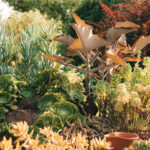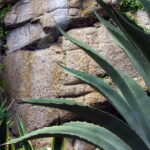Explore Luxurious Velvet-Leaf Succulents for Your Garden
Vibrant and eye-catching, velvet-leaf succulents have become a popular choice for garden enthusiasts looking to add a touch of luxury to their outdoor spaces. These exquisite plants, known for their velvety texture and unique leaf shapes, bring a sense of elegance and sophistication to any garden or landscape.
We will delve into the world of velvet-leaf succulents, exploring their various types and characteristics. We will discuss the best practices for growing and caring for these plants, including tips on watering, sunlight requirements, and soil preferences. Additionally, we will highlight some creative ways to incorporate velvet-leaf succulents into your garden design, from stunning container arrangements to vertical gardens. Whether you are a seasoned gardener or a beginner, this article will provide you with the knowledge and inspiration to cultivate your own luxurious velvet-leaf succulent garden.
- Add a touch of elegance to your garden with velvet-leaf succulents
- Create a lush and luxurious garden with these stunning plants
- Enjoy the unique texture and rich colors of velvet-leaf succulents in your outdoor space
- Enhance the beauty of your garden with these sophisticated and eye-catching plants
- Discover the versatility of velvet-leaf succulents, perfect for any garden style
- Transform your garden into a luxurious oasis with the addition of velvet-leaf succulents
- Impress your guests with the elegance and beauty of velvet-leaf succulents in your garden
- Experiment with different varieties of velvet-leaf succulents to create a stunning display
- Enjoy the low maintenance and durability of velvet-leaf succulents in your garden
- Elevate your garden design with the addition of these unique and exquisite plants
- Frequently Asked Questions
Add a touch of elegance to your garden with velvet-leaf succulents
If you're looking to add a touch of luxury and sophistication to your garden, look no further than velvet-leaf succulents. These stunning plants are known for their soft, velvety leaves that come in a variety of rich, vibrant colors. Whether you have a small balcony garden or a sprawling backyard, velvet-leaf succulents are the perfect addition to elevate your outdoor space.
Why choose velvet-leaf succulents?
There are many reasons why velvet-leaf succulents are a popular choice among garden enthusiasts. Firstly, their unique foliage sets them apart from other succulents. The velvety texture of their leaves adds a touch of luxury and opulence to any garden setting.
Secondly, velvet-leaf succulents are easy to care for, making them a great option for both novice and experienced gardeners. These plants are known for their ability to thrive in various conditions, including low light and dry environments. They require minimal watering and maintenance, making them ideal for those with busy schedules.
Types of velvet-leaf succulents
Velvet-leaf succulents come in a wide variety of species, each with its own unique characteristics. Some popular types include:
 Unveiling the World of Succulent Plants and Their Unique Traits
Unveiling the World of Succulent Plants and Their Unique Traits- Kalanchoe tomentosa: Also known as "Panda Plant," this succulent features fuzzy, silver-green leaves with chocolate-brown markings.
- Sedum morganianum: Commonly referred to as "Burro's Tail," this succulent has long, trailing stems covered in plump, blue-green leaves.
- Echeveria affinis: With its dark purple, almost black leaves, this succulent adds a touch of drama and elegance to any garden.
- Pachyphytum oviferum: Known as "Moonstones," this succulent has round, chubby leaves that resemble the shape of pearls.
How to care for velvet-leaf succulents
Caring for velvet-leaf succulents is relatively straightforward. Here are a few tips to ensure they thrive in your garden:
- Light: Place your velvet-leaf succulents in a spot that receives bright, indirect sunlight. Avoid exposing them to harsh, direct sunlight, as it can scorch their leaves.
- Water: Velvet-leaf succulents have low water needs. Allow the soil to dry out completely between waterings, and be cautious not to overwater them.
- Soil: Use a well-draining soil mix specifically designed for succulents. This will prevent waterlogging and root rot.
- Temperature: Velvet-leaf succulents prefer temperatures between 60-75°F (15-24°C). Protect them from frost and extreme heat.
- Propagation: These succulents can be propagated through stem or leaf cuttings. Simply allow the cuttings to callus over before planting them in well-draining soil.
With their luxurious foliage and easy care requirements, velvet-leaf succulents are a must-have for any garden lover. Whether you choose to display them in pots or incorporate them in your landscape design, these plants are sure to impress with their elegance and beauty.
Create a lush and luxurious garden with these stunning plants
If you're looking to add a touch of elegance and opulence to your garden, look no further than velvet-leaf succulents. These remarkable plants are known for their soft, velvety leaves that come in a variety of rich, vibrant colors. With their unique texture and striking appearance, they are sure to be the showstoppers in any garden.
Why choose velvet-leaf succulents?
Velvet-leaf succulents, also known as Kalanchoe beharensis, are a popular choice among garden enthusiasts for several reasons. First and foremost, their velvety leaves add a luxurious and sumptuous feel to any garden setting. Their unique texture sets them apart from other succulents, making them a standout feature in any landscape.
Additionally, velvet-leaf succulents are incredibly low maintenance. They are highly adaptable and can thrive in a variety of environments, making them perfect for both indoor and outdoor gardens. Whether you have a green thumb or are new to gardening, these plants are relatively easy to care for, making them an ideal choice for beginners and experienced gardeners alike.
Colors and varieties
One of the most exciting aspects of velvet-leaf succulents is the wide range of colors and varieties available. From deep shades of green to silver-gray, their leaves come in an array of stunning hues. Some varieties even have hints of copper or burgundy, adding a touch of drama and sophistication to your garden.
Popular varieties of velvet-leaf succulents include:
 Non-Cactus Succulents: A Guide to Other Succulent Varieties
Non-Cactus Succulents: A Guide to Other Succulent Varieties- Kalanchoe beharensis 'Fang': This variety has large, fang-shaped leaves with a silver-gray color. Its unique leaf shape and color make it a striking addition to any garden.
- Kalanchoe beharensis 'Oak Leaf': As the name suggests, this variety has leaves that resemble oak leaves. They are a deep shade of green, giving your garden a lush and natural look.
- Kalanchoe beharensis 'Copper Spoons': This variety features leaves with a stunning coppery hue. The color intensifies with sun exposure, adding warmth and richness to your garden.
Caring for velvet-leaf succulents
While velvet-leaf succulents are relatively low maintenance, it's essential to provide them with the right care to ensure their optimal growth and health. Here are some care tips to keep in mind:
- Light: Place your velvet-leaf succulents in a location where they can receive bright, indirect sunlight. Avoid exposing them to harsh, direct sunlight, as it can scorch their leaves.
- Watering: Water your velvet-leaf succulents sparingly, allowing the soil to dry out completely between waterings. Overwatering can lead to root rot, so it's crucial to strike the right balance.
- Soil: Use well-draining soil specifically formulated for succulents. This type of soil will prevent water from pooling around the roots, preventing root rot.
- Temperature: Velvet-leaf succulents prefer warm temperatures between 60°F and 75°F (15°C and 24°C). Protect them from frost and extreme cold to avoid damage to their leaves.
By following these care guidelines, you can enjoy the beauty of velvet-leaf succulents in your garden for years to come. Their striking appearance and low maintenance nature make them a fantastic addition to any garden, whether you're going for a luxurious and elegant look or simply want to add a touch of flair to your outdoor space.
Enjoy the unique texture and rich colors of velvet-leaf succulents in your outdoor space
Velvet-leaf succulents are a stunning addition to any garden, with their unique texture and rich colors. These plants, also known as Kalanchoe beharensis, belong to the Crassulaceae family and are native to Madagascar. Their large, velvety leaves and compact growth habit make them a popular choice for both indoor and outdoor gardens.
Why choose velvet-leaf succulents?
There are several reasons why velvet-leaf succulents are worth considering for your garden:
- Their velvety leaves, covered in fine hairs, give them a soft and luxurious texture that is visually appealing.
- They come in a variety of colors, including shades of green, silver, and even bronze, adding a touch of elegance to your garden.
- Velvet-leaf succulents are relatively low-maintenance plants, making them suitable for both experienced gardeners and beginners.
- These succulents are drought-tolerant and can withstand dry conditions, making them perfect for areas with limited water resources.
How to care for velvet-leaf succulents
To ensure the health and vitality of your velvet-leaf succulents, follow these care tips:
- Light: Place your plants in a location that receives bright, indirect sunlight. Avoid exposing them to direct sunlight, as it can scorch their leaves.
- Watering: Allow the soil to dry out completely between waterings. Overwatering can lead to root rot, so it's essential to practice moderation.
- Soil: Use well-draining soil specifically formulated for succulents. This will prevent excess moisture and ensure proper root development.
- Fertilizer: Feed your velvet-leaf succulents with a balanced, diluted fertilizer during the growing season to promote healthy growth.
- Pruning: Trim any dead or damaged leaves to maintain the plant's appearance and prevent the spread of diseases.
With the right care and attention, your velvet-leaf succulents will thrive and become a focal point in your garden. Their luxurious texture and vibrant colors will add a touch of sophistication to any outdoor space. So why not consider adding these stunning succulents to your garden and enjoy their beauty year-round?
 Discover the Enchanting Beauty of Ruffled Succulent Leaves
Discover the Enchanting Beauty of Ruffled Succulent LeavesEnhance the beauty of your garden with these sophisticated and eye-catching plants
If you're looking to add a touch of elegance and luxury to your garden, look no further than velvet-leaf succulents. These stunning plants are known for their soft and velvety foliage, which adds a unique texture and visual appeal to any outdoor space.
Why choose velvet-leaf succulents?
Velvet-leaf succulents, also known as Kalanchoe beharensis, are a popular choice among plant enthusiasts for several reasons. Firstly, their plush leaves have a rich, deep green color that adds a sense of opulence and sophistication to your garden. Secondly, their unique texture sets them apart from other succulents, making them a standout feature in any landscape. Lastly, these plants are relatively low-maintenance, making them perfect for both seasoned gardeners and beginners.
Types of velvet-leaf succulents
There are several varieties of velvet-leaf succulents to choose from, each with its own distinctive characteristics. Here are a few popular options:
- Kalanchoe beharensis 'Fang': This variety has elongated leaves with serrated edges, resembling the fangs of a vampire. It grows upright and can reach an impressive height, making it a great choice for adding vertical interest to your garden.
- Kalanchoe beharensis 'Oak Leaf': As the name suggests, the leaves of this variety resemble the shape of oak leaves. They have a beautiful coppery-green color and a velvety texture that adds a touch of warmth to your garden.
- Kalanchoe beharensis 'Teddy Bear': This cultivar is a dwarf version of the velvet-leaf succulent, featuring small, rounded leaves that are incredibly soft to the touch. It's perfect for containers or small gardens where space is limited.
How to care for velvet-leaf succulents
Caring for velvet-leaf succulents is relatively simple, as they are drought-tolerant plants. Here are some basic care tips:
- Light: Velvet-leaf succulents thrive in bright, indirect light. Place them in a location where they can receive a few hours of morning or evening sun without being exposed to harsh midday rays.
- Watering: These plants have adapted to survive in arid conditions, so they prefer infrequent watering. Allow the soil to dry out completely between waterings to prevent root rot.
- Soil: Velvet-leaf succulents require well-draining soil to prevent waterlogged roots. Use a succulent or cactus mix that provides excellent drainage.
- Temperature: These succulents prefer warm temperatures between 60-80°F (15-27°C). Protect them from frost and extreme cold conditions.
With their velvety foliage and unique texture, velvet-leaf succulents are sure to elevate the aesthetic appeal of your garden. Whether you choose the 'Fang', 'Oak Leaf', or 'Teddy Bear' variety, these plants will add a touch of luxury and sophistication to any outdoor space. So why not give your garden a touch of opulence with these mesmerizing succulents?
Discover the versatility of velvet-leaf succulents, perfect for any garden style
If you're looking to add a touch of elegance and luxury to your garden, look no further than velvet-leaf succulents. These stunning plants are known for their velvety, soft leaves that give them a unique and sophisticated appearance. Whether you have a modern, minimalist garden or a lush, tropical oasis, velvet-leaf succulents can effortlessly complement any garden style.
Variety of Colors and Textures
One of the reasons why velvet-leaf succulents are so popular is their wide range of colors and textures. From deep purples and rich burgundies to vibrant greens and silvers, these plants offer a diverse palette to choose from. Some varieties even have contrasting veins or patterns on their leaves, adding an extra element of visual interest to your garden.
 Fast-Growing Succulents: Seed-Grown Varieties Revealed
Fast-Growing Succulents: Seed-Grown Varieties RevealedLow-Maintenance and Drought-Tolerant
Velvet-leaf succulents are not only beautiful but also incredibly easy to care for. These plants are well-suited for busy gardeners or those who want to conserve water. As succulents, they have adapted to survive in arid conditions and can tolerate long periods of drought. Their fleshy leaves store water, allowing them to thrive with minimal watering.
If you live in an area with hot, dry summers or have a tendency to forget to water your plants, velvet-leaf succulents are the perfect choice for you. Simply plant them in well-draining soil, place them in a sunny spot, and watch them flourish with little effort on your part.
Versatile Planting Options
Another advantage of velvet-leaf succulents is their versatility when it comes to planting options. These plants can thrive in various settings, including containers, rock gardens, or as groundcover. Their compact size makes them ideal for small gardens or balconies, while their trailing habits make them perfect for hanging baskets or cascading over retaining walls.
Consider mixing different varieties of velvet-leaf succulents together for a visually stunning display. Their contrasting colors and textures will create a vibrant and eye-catching focal point in your garden.
Final Thoughts
If you're looking to elevate your garden with a touch of luxury and sophistication, velvet-leaf succulents are a fantastic choice. With their stunning colors, easy maintenance, and versatile planting options, these plants can add a unique charm to any garden style. Whether you have a small urban courtyard or a sprawling backyard, velvet-leaf succulents are sure to make a statement.
Transform your garden into a luxurious oasis with the addition of velvet-leaf succulents
When it comes to creating a stunning garden, it's all about finding unique and eye-catching plants. If you're looking to add a touch of luxury to your outdoor space, consider incorporating velvet-leaf succulents into your garden design. These stunning plants are known for their soft, velvety leaves and come in a variety of shapes, sizes, and colors.
 Exploring the Fascinating World of Tree-Like Succulent Plants
Exploring the Fascinating World of Tree-Like Succulent PlantsWhy Choose Velvet-Leaf Succulents?
Velvet-leaf succulents are not only visually appealing but also incredibly low maintenance. These plants have adapted to survive in harsh desert conditions, making them perfect for busy gardeners or those with limited gardening experience. They require little water and are highly tolerant of drought, making them an excellent choice for arid climates.
One of the standout features of velvet-leaf succulents is their unique foliage. The leaves of these plants have a velvety texture, giving them an elegant and luxurious appearance. Some varieties have leaves with a soft silver sheen, while others boast vibrant hues of purple or green. Whether you prefer a monochromatic color scheme or a mix of shades, there is a velvet-leaf succulent to suit your taste.
How to Incorporate Velvet-Leaf Succulents into Your Garden
There are several ways to incorporate velvet-leaf succulents into your garden design. Here are a few ideas to get you started:
- Container Gardens: Create stunning focal points by planting velvet-leaf succulents in decorative containers. Mix and match different varieties to add texture and interest to your outdoor space.
- Rock Gardens: Velvet-leaf succulents thrive in rocky soil, making them an ideal choice for rock gardens. Plant them among stones and boulders to create a natural and visually appealing display.
- Vertical Gardens: Take advantage of the unique growth habits of velvet-leaf succulents by incorporating them into a vertical garden. Install a trellis or wall-mounted planter and let the succulents cascade down for a stunning effect.
Remember to consider the specific needs of each variety when deciding where to plant your velvet-leaf succulents. Some prefer full sun, while others thrive in partial shade. By providing the right growing conditions, you can ensure that your succulents thrive and continue to enhance the luxurious appeal of your garden.
Velvet-leaf succulents are a fantastic addition to any garden, adding a touch of luxury and elegance. With their unique foliage and low maintenance requirements, these plants are a great choice for both experienced gardeners and beginners. So why not transform your outdoor space into a luxurious oasis with the addition of velvet-leaf succulents?
Impress your guests with the elegance and beauty of velvet-leaf succulents in your garden
If you're looking for a unique and eye-catching addition to your garden, look no further than velvet-leaf succulents. These stunning plants not only add a touch of luxury to any outdoor space, but they are also relatively low-maintenance and easy to care for.
Velvet-leaf succulents, also known as Kalanchoe beharensis, are native to Madagascar and are known for their distinct velvety texture and beautiful foliage. Their leaves, which are covered in a soft, fuzzy layer, resemble the texture of velvet, giving these plants their name. This unique feature sets them apart from other succulents and makes them a popular choice among plant enthusiasts.
 Spiky Succulents: A Guide to Thorny and Spiky Types
Spiky Succulents: A Guide to Thorny and Spiky TypesWhy choose velvet-leaf succulents?
One of the main reasons to choose velvet-leaf succulents for your garden is their striking appearance. The velvety texture of their leaves creates a visual appeal that is hard to resist. These plants come in various shades of green, ranging from deep emerald to silvery-gray, adding depth and dimension to your garden.
Additionally, velvet-leaf succulents have a compact growth habit, making them ideal for small gardens or container gardening. They can thrive in both indoor and outdoor environments, allowing you to enjoy their beauty year-round, regardless of the weather conditions.
How to care for velvet-leaf succulents
Despite their luxurious appearance, velvet-leaf succulents are relatively easy to care for. Here are some essential tips to ensure their health and longevity:
- Light: Velvet-leaf succulents thrive in bright, indirect light. Place them in a location where they can receive a few hours of sunlight each day, but avoid exposing them to direct, intense sunlight, as it can scorch their leaves.
- Water: These succulents have moderate water requirements. Water them thoroughly when the top inch of soil feels dry to the touch, but be careful not to overwater, as it can lead to root rot. Allow the soil to dry out between waterings.
- Soil: Velvet-leaf succulents prefer well-draining soil. Use a succulent or cactus potting mix that provides excellent drainage to prevent waterlogged roots.
- Temperature and humidity: These plants thrive in temperatures between 60-75°F (15-24°C) and prefer moderate humidity levels. Avoid exposing them to extreme temperature fluctuations or high humidity conditions.
- Fertilizer: Feed velvet-leaf succulents with a balanced, water-soluble fertilizer once a month during the growing season (spring and summer). Follow the instructions on the fertilizer packaging for proper dosage.
Design ideas for incorporating velvet-leaf succulents
Now that you know how to care for velvet-leaf succulents, it's time to get creative with their placement in your garden. Here are a few design ideas to inspire you:
- Create a succulent rock garden by combining velvet-leaf succulents with other low-growing succulents and rocks of different sizes.
- Plant them in decorative containers and use them as a centerpiece for your outdoor dining table or as accents on your patio.
- Combine velvet-leaf succulents with spiky succulents, such as agave or yucca, to create a visually dynamic and textural garden bed.
- Grow them in hanging baskets or vertical gardens to add a touch of elegance to your walls or fences.
With their luxurious appearance and easy care requirements, velvet-leaf succulents are a fantastic choice for any garden enthusiast. Whether you're a seasoned gardener or just starting, these plants will surely impress your guests and become a standout feature in your outdoor space.
Experiment with different varieties of velvet-leaf succulents to create a stunning display
Velvet-leaf succulents are a popular choice among garden enthusiasts due to their unique and luxurious appearance. These stunning plants are characterized by their soft, velvety leaves that add a touch of elegance and sophistication to any garden or indoor space. If you are looking to create a visually striking display, experimenting with different varieties of velvet-leaf succulents is a must.
Choosing the Right Variety
When selecting velvet-leaf succulents for your garden, you will be spoilt for choice with a wide range of options available. Each variety offers its own distinctive features, from different leaf shapes and sizes to varying shades of green and purple. Some popular varieties include:
 Vibrant Blooming Outdoor Succulents: Discover Stunning Plants
Vibrant Blooming Outdoor Succulents: Discover Stunning Plants- Echeveria Black Prince: This variety boasts deep, dark purple leaves that almost appear black. Its rosette-like shape and velvety texture make it a perfect addition to any succulent arrangement.
- Kalanchoe Tomentosa: Commonly known as "Panda Plant," this variety showcases silvery-green leaves covered in fine hairs that give it a fuzzy, velvety appearance. Its compact size makes it an ideal choice for small spaces or indoor gardens.
- Aeonium Schwarzkopf: With its striking burgundy-black foliage, this variety adds a touch of drama and elegance to any garden. Its rosette-shaped leaves are velvety to the touch, creating a visually captivating display.
Caring for Velvet-Leaf Succulents
While velvet-leaf succulents are known for their stunning appearance, they also require proper care to thrive. Here are some essential care tips:
- Light: Place your velvet-leaf succulents in a location that receives bright, indirect sunlight. Avoid exposing them to direct sunlight for extended periods, as it can lead to sunburn.
- Watering: Succulents are known for their drought-tolerant nature, and velvet-leaf varieties are no exception. Allow the soil to dry out completely between waterings and be cautious not to overwater, as it can cause root rot.
- Soil: Use well-draining soil specifically formulated for succulents to prevent waterlogging. Adding perlite or sand can further enhance drainage.
- Fertilizing: Feed your velvet-leaf succulents with a balanced, water-soluble fertilizer during the growing season. Follow the instructions on the fertilizer package for the appropriate dosage.
By following these care guidelines and selecting the right varieties, you can create a stunning display of velvet-leaf succulents that will be the envy of every garden aficionado. So, why wait? Start exploring the world of velvet-leaf succulents and elevate the beauty of your garden today!
Enjoy the low maintenance and durability of velvet-leaf succulents in your garden
Are you tired of constantly having to water and care for delicate plants in your garden? If so, it's time to consider adding velvet-leaf succulents to your collection. These stunning plants not only require minimal maintenance but also offer a touch of luxury with their velvety texture and unique leaf patterns.
Velvet-leaf succulents, also known as Kalanchoe beharensis, are native to Madagascar and are now gaining popularity among garden enthusiasts worldwide. Their thick, fuzzy leaves are a standout feature that distinguishes them from other succulents. The velvety texture creates an inviting visual and tactile experience, adding a touch of opulence to any garden.
One of the biggest advantages of velvet-leaf succulents is their ability to thrive in various conditions. Whether you have a sunny garden or a shaded patio, these plants can adapt and flourish. Their robust nature makes them highly durable, perfect for both beginner and experienced gardeners looking for low-maintenance options.
Benefits of velvet-leaf succulents in your garden
- Low water requirements: Velvet-leaf succulents are known for their ability to store water in their leaves, making them highly drought-tolerant. This means less frequent watering and reduced water consumption, making them an eco-friendly choice.
- Year-round interest: Unlike some plants that bloom for a short period, velvet-leaf succulents offer year-round visual interest with their attractive foliage. Their unique leaf shapes and colors add texture and depth to your garden, creating a captivating display.
- Easy propagation: If you want to expand your collection or share these beauties with friends, velvet-leaf succulents are incredibly easy to propagate. Simply take a leaf or stem cutting, allow it to dry and callous, then plant it in well-draining soil. Before you know it, you'll have new plants ready to adorn your garden.
- Indoor and outdoor versatility: Velvet-leaf succulents are versatile plants that can thrive both indoors and outdoors. Whether you want to add a touch of elegance to your living room or create a lush garden oasis, these succulents are an excellent choice.
Ready to introduce the luxurious vibe of velvet-leaf succulents to your garden? With their low maintenance requirements and exceptional durability, these plants are sure to elevate your gardening experience. Embrace the beauty of nature with these stunning succulents and enjoy a garden that exudes elegance and sophistication.
 Discover the Perfect Buddha Temple Succulent for Your Home
Discover the Perfect Buddha Temple Succulent for Your HomeElevate your garden design with the addition of these unique and exquisite plants
Velvet-leaf succulents are a stunning addition to any garden, adding a touch of elegance and luxury to your outdoor space. These plants, also known as Kalanchoe beharensis, are characterized by their plush velvet-like leaves that come in a variety of rich shades, ranging from deep green to vibrant silver.
One of the main reasons why velvet-leaf succulents have become so popular among garden enthusiasts is their ability to thrive in various conditions. Whether your garden receives full sun, partial shade, or even indirect light, these plants will flourish and bring beauty to your landscape.
Benefits of Velvet-Leaf Succulents
Aside from their stunning appearance, velvet-leaf succulents offer a range of benefits that make them a worthwhile addition to your garden:
- Drought-tolerant: These plants have adapted to thrive in arid conditions, making them a perfect choice for water-wise gardens.
- Low maintenance: Velvet-leaf succulents are relatively easy to care for, requiring minimal attention and effort.
- Air-purifying properties: Studies have shown that succulents, including velvet-leaf varieties, can improve air quality by removing toxins and releasing oxygen.
- Unique texture: The velvety leaves of these succulents create a visually striking texture that adds depth and interest to your garden.
- Attracts pollinators: The vibrant flowers that emerge from velvet-leaf succulents attract bees and butterflies, promoting biodiversity in your garden.
How to Incorporate Velvet-Leaf Succulents into Your Garden
There are numerous ways to incorporate velvet-leaf succulents into your garden design. Here are a few ideas to inspire you:
- Container gardens: Plant velvet-leaf succulents in decorative containers and place them strategically around your patio or outdoor seating area for a touch of sophistication.
- Rock gardens: Create a captivating rock garden by pairing velvet-leaf succulents with other low-maintenance plants and gravel or pebble accents.
- Vertical gardens: Take advantage of the unique trailing growth habit of velvet-leaf succulents by incorporating them into vertical gardens or living walls.
- Groundcover: Use these succulents as a groundcover to fill in empty spaces between larger plants, adding texture and visual interest to your garden beds.
- Mixed planters: Combine velvet-leaf succulents with other complementary plants, such as colorful annuals or contrasting foliage, to create eye-catching mixed planters.
With their luxurious appearance and numerous benefits, velvet-leaf succulents are a must-have for any garden enthusiast looking to elevate their outdoor space. Whether you have a small balcony or a spacious backyard, these plants will add a touch of opulence and sophistication to your garden design.
Frequently Asked Questions
1. What are velvet-leaf succulents?
Velvet-leaf succulents are a type of plant that have soft, velvety leaves and store water in their leaves, stems, or roots. They are known for their unique texture and vibrant colors.
 Best Pink Flowering Ground Cover Succulents for Your Garden
Best Pink Flowering Ground Cover Succulents for Your Garden2. How do I care for velvet-leaf succulents?
Velvet-leaf succulents require well-draining soil, plenty of sunlight, and occasional watering. They are drought-tolerant plants and should be protected from frost and overwatering.
3. Can velvet-leaf succulents be grown indoors?
Yes, velvet-leaf succulents can be grown indoors as long as they receive adequate sunlight. Place them near a sunny window or use artificial grow lights to ensure they get the light they need.
4. Are velvet-leaf succulents toxic to pets?
Some varieties of velvet-leaf succulents can be toxic to pets if ingested. It is best to keep them out of reach of curious pets or opt for non-toxic succulent varieties if you have pets in your home.
